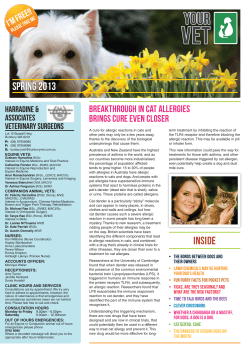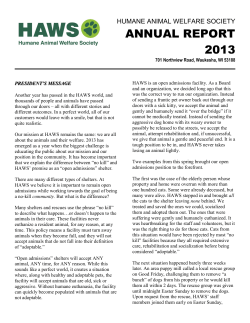
Twice Daily Trilostane for Pituitary-Dependent Hyperadrenocorticism
capsules CONTINUED Twice Daily Trilostane for Pituitary-Dependent Hyperadrenocorticism One of the most common endocrine disorders of middle-aged and older dogs, hyperadrenocorticism, is primarily pituitary-dependent (PDH). Currently, the most common therapy for PDH is mitotane. Although mitotane has fairly good efficacy, side effects and other disadvantages are possible. A promising new drug is trilostane, a competitive inhibitor of β-hydroxysteroid dehydrogenase that processes the conversion of pregnenolone to progesterone in the adrenal gland.This study was designed to determine the efficacy and toxicity of twice-daily dosing of trilostane in dogs with PDH and to evaluate the long-term effects. Initially, dogs were dosed as follows: dogs weighing less than 5 kg were given 15 mg PO Q 12 H, dogs weighing 5 to 20 kg were give 30 mg PO Q 12 H, dogs weighing 20 to 40 kg received 60 mg PO in the morning and 30 mg PO in the evening, and dogs weighing more than 40 kg received 60 mg PO Q 12 hours.The dogs were reevaluated at 7 days and at 1, 3, and 6 months after initiation of treatment and every 6 months thereafter. At the first evaluation, an adrenocorticotropin hormone stimulation test was performed 4 to 6 hours after administration of trilostane. Overall, the dogs did well and had a mean survival time of 930 days; however, because some dogs are still alive, final survival days cannot be calculated. In previous studies, dogs treated with trilostane once a day had a mean survival of 540 days and dogs treated with mitotane survived 803 days. COMMENTARY: Although twice-daily dosing may not be as convenient for the owner, the lower overall doses and longer survival were certainly a benefit. Since about 25% of the treated dogs had at least one episode of hypoadrenocorticism, it is advisable to examine patients every 3 to 6 months, even when they appear clinically normal.—Patricia Thomblison, DVM, MS Long-term efficacy of trilostane administered twice daily in dogs with pituitary-dependent hyperadrenocorticism. Alenza DP, Arenas C, Lopez ML, Melian C.JAAHA 42:269-276, 2006. Tea Tree Oil for Prostatic Abscess? Abscess is one of the most common prostatic diseases in dogs.Because of the blood-prostate barrier, only a few lipid-soluble antibiotics are effective when given systemically, and treatment must be continued for 3 to 6 weeks. Surgical treatment carries risks; thus, a good nonsurgical treatment has been sought.Tea tree oil is an essential oil with antiinflammatory and antifungal activity, as well as potent antimicrobial activity against a broad spectrum of gram-positive and gram-negative bacteria, including Escherichia coli and Staphylococcus aureus. In this study, the therapeutic effect of tea tree oil was assessed as a treatment for canine prostatic abscesses. The purulent material from the prostatic abscesses of 6 dogs was removed via ultrasound-guided transabdominal needle aspiration.Tea tree oil, equal to the volume of purulent material removed, was then injected into the cavities of the abscesses. Cultures of the purulent material revealed E coli or S aureus in 5 dogs and Enterococcus species in the sixth dog. Ultrasonographic evaluation of the dogs 3 weeks later revealed markedly reduced prostatic abscess cavities in 2 dogs and slightly contracted cavities in 4 dogs. Removal of purulent material followed by injection of tea tree oil into the prostatic abscesses of these 4 dogs was repeated. No purulent material was found 3 weeks after the second treatment. Pyrexia and anorexia seen at the beginning of the study had improved in all 6 dogs 3 weeks after the first treatment, and all clinical signs (including dysuria, dyschezia, and abdominal pain) had resolved within 3 to 6 weeks after the first treatment.The prostatic abscesses had not recurred in any of the dogs after more than 1 year. COMMENTARY: Prostatic infections occur in 40% of dogs with prostatic disease, and the presence of abscessation with prostatitis varies, occurring in 60% of these patients in 1 study.While this study presents an intriguing possibility for managing canine prostatic abscesses, care must be taken in a procedure such as this one to avoid creating sepsis along the aspiration needle track. However, if treatment with systemic antibiotics and induction of prostatic involution (eg, castration) do not resolve the abscess, tea tree oil could be an interesting alternative to surgery. Further studies using more patients would be necessary to investigate this as a possible option.—Jennifer L. Schori,VMD Treatment of prostatic abscesses by aspiration of purulent matter and injection with tea tree oil into the cavities of dogs. Kawakami E,Washizu M, Hirano T, et al.J VET MED SCI 68:1215-1217, 2006. c o n t i n u e s 5 0 . . . . . N AV C c l i n i c i a n’s b r i e f . a p r i l . 2 0 0 7 . . . . . . . . . . . . . . . . . . . . . . . . . . . . . . . . . . . . . . . . . . . . . . . . . . . . . . . . . . . . . . . . . . . . . . . . . . . . . . . . . . . . . . . . . . . . . . . . . . . . . . . . . . . . . . . . . . . . . . . . . . . . . . . . . . . . . . . . c a p s u l e s
© Copyright 2025





















